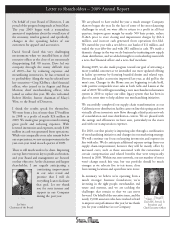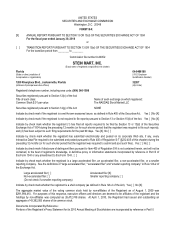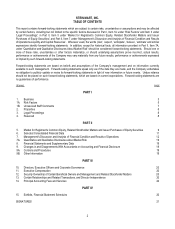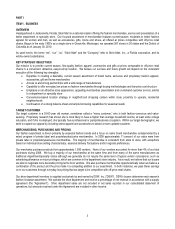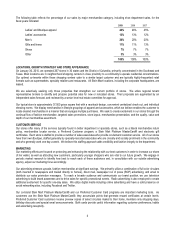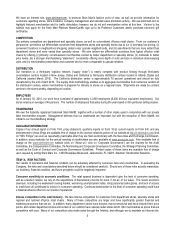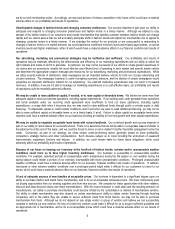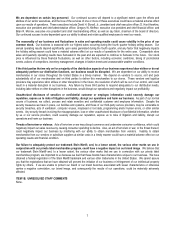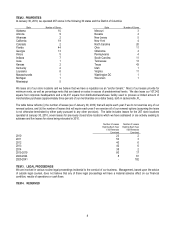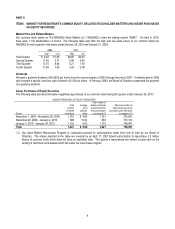Stein Mart 2009 Annual Report Download - page 8
Download and view the complete annual report
Please find page 8 of the 2009 Stein Mart annual report below. You can navigate through the pages in the report by either clicking on the pages listed below, or by using the keyword search tool below to find specific information within the annual report.we do not sell merchandise online. Accordingly, we may face periods of intense competition in the future which could have a material
adverse effect on our profitability and results of operations.
Unanticipated changes in fashion trends and changing consumer preferences. Our success depends in part upon our ability to
anticipate and respond to changing consumer preferences and fashion trends in a timely manner. Although we attempt to stay
abreast of the fashion tastes of our customers and provide merchandise that satisfies customer demand, fashion trends can change
rapidly and we cannot assure that we will accurately anticipate shifts in fashion trends and adjust our merchandise mix to appeal to
changing consumer tastes in a timely manner. If we misjudge the market for our products or are unsuccessful in responding to
changes in fashion trends or in market demand, we could experience insufficient inventory levels and missed opportunities, or excess
inventory levels and higher markdowns, either of which would have a material adverse effect on our financial condition and results of
operations.
Our advertising, marketing and promotional strategies may be ineffective and inefficient. Our profitability and results of
operations may be materially affected by the effectiveness and efficiency of our marketing expenditures and our ability to select the
right markets and media in which to advertise. In particular, we may not be successful in our efforts to create greater awareness of
our stores and our promotions, identify the most effective and efficient level of spending in each market and specific media vehicle
and determine the appropriate creative message and media mix for our advertising, marketing and promotional expenditures. While
we utilize several methods of distribution, daily newspapers are an important delivery vehicle for both run of press advertising and
circular insertions. The newspaper business is under increasing economic pressure, and the demise of certain newspapers would
jeopardize an important distribution method for our advertising. Our planned marketing expenditures may not result in increased
revenues. In addition, if we are not able to manage our marketing expenditures on a cost-effective basis, our profitability and results
of operations could be materially adversely affected.
We may be unable to raise additional capital, if needed, or to raise capital on favorable terms. We believe we have more than
adequate capital to fund our business operations, including capital expenditures. If our existing cash, cash generated from operations
and funds available under our revolving credit agreement were insufficient to fund our future operations, including capital
expenditures, or repay debt when it becomes due, we may need to raise additional funds through public or private equity or debt
financing. If unfavorable capital or credit market conditions exist if and when we were to seek additional financing, we may not be
able to raise sufficient capital on favorable terms or on a timely basis, if at all. Failure to obtain capital on acceptable terms when
required could have a material adverse effect on our business including an inability to fund new growth and other capital expenditures.
We may be unable to negotiate acceptable lease terms with current landlords. Our continued growth and success depends in
part on our ability to renew leases for successful stores. There is no assurance that we will be able to re-negotiate leases at similar or
favorable terms at the end of the lease, and we could be forced to move or exit a market if another favorable arrangement cannot be
made. Conversely, as part of our strategy, we close certain under-performing stores, generally based on store profitability,
competition, strategic factors and other considerations. Such closures subject us to costs including the write-down of leasehold
improvements, equipment, furniture and fixtures. In addition, we could remain liable for future lease obligations, which could
adversely affect our profitability and results of operations.
Because of our focus on keeping our inventory at the forefront of fashion trends, extreme and/or unseasonable weather
conditions could force us to have higher inventory markdowns. Our business is susceptible to unseasonable weather
conditions. For example, extended periods of unseasonably warm temperatures during the fall season or cool weather during the
spring season could render a portion of our inventory incompatible with those unseasonable conditions. Prolonged unseasonable
weather conditions could have a material adverse effect on our business, financial condition and results of operations. In addition,
hurricanes or other extreme weather conditions over a prolonged period might make it difficult for our customers to travel to our
stores, which could have a material adverse effect on our business, financial condition and results of operations.
A lack of adequate sources of merchandise at acceptable prices. Our business is dependent to a significant degree upon our
ability to purchase fashion and brand name merchandise, and to do so at acceptable wholesale prices. We must continuously seek
out buying opportunities from our existing suppliers and from new sources. We compete for these opportunities with other retailers,
discount and deep-discount chains and mass merchandisers. With the recent downturn in retail sales and the resulting pressure on
manufacturers, our ability to purchase merchandise could become limited by the consolidation or demise of merchandise vendors.
Our ability to obtain merchandise may also depend on certain manufacturers’ ability to obtain vendor financing through factoring
companies, and to the extent they are unable to secure sufficient credit from those factors, we may not be able to purchase
merchandise from them. Although we do not depend on any single vendor or group of vendors and believe we can successfully
compete in seeking out new vendors, the loss of certain key vendors could make it difficult for us to acquire sufficient quantities and
an appropriate mix of merchandise, and to do so at acceptable prices which could have a material adverse effect on our results of
operations.
6


